History of Downtown Alameda
Self-Guided Walking Tour
Sometimes, "What's New?" isn't as interesting as "What's Old?" That's certainly the case with our great old buildings.
The Park Street Historic Commercial District has been a place of business and commerce for more than 150 years. If you look closely, you'll see that the architectural features of the older buildings are reflective of the time they were built and encompass the Victorian, Period Revivals, and Art Deco eras. The unique charm of the downtown streetscape also comes from how the smaller retail establishments co-exist alongside a number of monumental buildings.
We invite you to take a self-guided tour of our historic district and marvel at the sights that make Downtown Alameda a unique place to eat, shop, and play.
Click the map to begin your tour!

Stop 1:
Bernardi Cleaners
1222 Park Street
Completed in 1946
This building is a late but very fine example of Moderne style commercial architecture on a modest scale, notable for its stepped pylon, integral metal signage and high degree of historic integrity. It is also a prime example of how even small structures can contribute significantly to the overall character of a historic district.
It was built for Bernard Bernardi, who learned his trade in the family tailoring and laundering business established by his father in the 1920's, which was originally located directly across the street, at 1221.
Built by Albert Russello of Oakland at a cost of $18,000, the structure includes a rear apartment that served as Bernard’s residence.
The building has remained in its original splendor throughout its later owners that include a tropical fish store and now a restaurant.
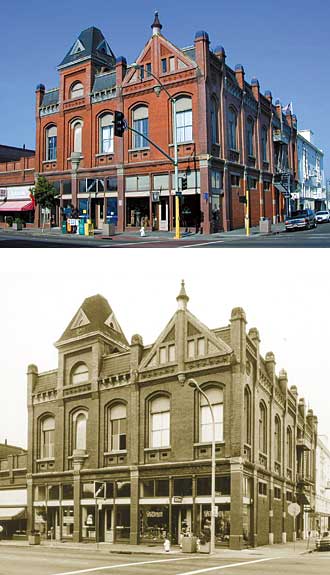
Stop 2:
Old Masonic Temple
1327-1331 Park Street
Completed in 1891
This is the last monumental Victorian building within the Park Street Commercial District in its original form -- a structure that helped define the profile of the street in nearly every photo taken after its completion in 1891.
The style is essentially Italianate with Queen Anne and Romanesque Revival elements. The dark red pressed brick facade is embellished with carved sandstone, granite, molded terra cotta, pressed galvanized iron, and slate.
Originally bid to be a three-story structure, plans were altered when construction bids exceeded budget. Designed by Oakland architect Charles Mau, the construction contract of $31,250 went to local brickmason James H. Cory.
The Masons final meeting in the Temple was in 1927, when a new temple was dedicated next door. They ultimately sold the building in 1979. Its ground-floor spaces are currently leased to various retail businesses, while its spectacular second floor and attic are being used as residential units.
As a true landmark structure, preservation efforts would help protect this extremely significant historical element. The Old Masonic Temple has been designated an Alameda Historical Monument (1979), is listed individually on the National Register (1982), and is listed as a contributor to the Park Street Historic Commercial District (National Register, 1982).

Stop 3:
Russell Franck Building
1349 Park Street
Completed in 1929
Erected at a cost of $15,000 to house Franck's Music Store, this is a charming example of a Spanish Colonial Revival commercial building. Its white-painted brick, stepped shed roof clad in red tile, round-topped chimney and wrought iron balcony present the image of an Andulusian village house.
Russell Franck ran his music/hi-fi store here until 1968, when it was sold to Lance Pederson and renamed Pederson's TV & Stereo. In 1988, it was purchased by Peggy and Richard Williams, who completed a sensitive conversion to a restaurant.
More recently, the building was turned into Tucker’s Ice Cream, Alameda’s sweet treat!
This building is one of Alameda’s best and most intact historic commercial structures, listed as a contributor to the Park Street Historic Commercial District (National Register, 1982).

Stop 4:
Old Alameda Theater
2315-2323 Central Avenue
Completed in 1932
The Alameda Theater is a masterpiece of Moderne architecture. It was designed by Miller & Pfleuger, whose other works include the Castro and Alhambra Theaters in San Francisco as well as Oakland's Paramount Theater. City documents list the cost of construction at $150,000, while newspaper articles from the time cited $500,000.
Commissioned by the Nasser Brothers, operators of a chain of Bay Area movie theaters, the Alameda Theater opened on August 15, 1932. In 1973, it was purchased by the Robert L. Lippert theater chain, and soon after underwent $85,000 in alterations, including the conversion of the balcony to two additional theaters.
Following its closure, the theater had been leased to a number of groups for various activities starting in 1979, including a roller skating rink, gymnastics school, and cabaret.
There was intense interest within the community in having the theater returned to its original splendor and purpose. So after years of neglect, AE Associated partnered with the City of Alameda to bring back the original splendor of the historic theatre. The Alameda Theatre & Cineplex successfully opened on May 24, 2008.
The Alameda Theater is an Alameda Historical Monument (1976) and is a major contributor to the Park Street Historic Commercial District (National Register, 1982).
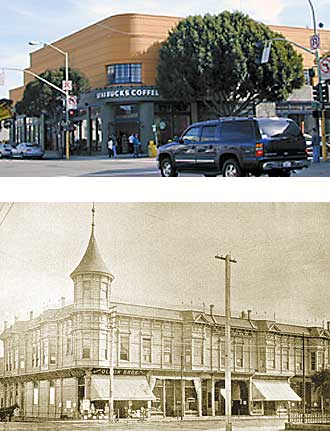
Stop 5:
Post Office Block/Commercial National Bank Building
1350-1364 Park Street
Completed in 1890
The Post Office Block was a landmark of 19th Century Park Street. Originally, it was a prominent example of Queen Anne commercial architecture, built for $30,000. William Patton, the designer, was a noted San Francisco architect and Alameda resident.
It housed Alameda's main post office from 1890-1900, and the Commercial National Bank starting in 1922. In 1938, the bank commissioned a major remodel by Oakland architect William Schirmer, resulted in the building’s present appearance.
This building is now an excellent example of Streamline Moderne, and contributes strongly to the Park Street Historic Commercial District (National Register, 1982).

Stop 6:
Alameda Savings Bank Building
1402-1410 Park Street
Completed in 1910
This handsome and intact building was erected as income property for the Alameda Savings Bank, at the time located next door.
Built at a cost of $30,000 by the Alameda firm of MacRae & Swenson, it was designed by San Francisco architects Meyers & Ward.
The stuccoed north wall is adjoined by a fragment of the Artesian Waterworks Building, which was demolished in 1955.
The building is noteworthy not only for its distinguished architecture, but for its historic integrity. It is a strong contributor to the Park Street Historic Commercial District (National Register, 1982).
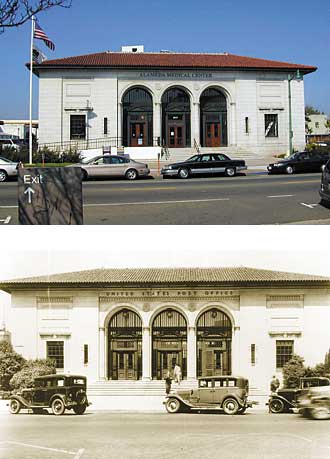
Stop 7:
Old Alameda Post Office
2417 Central Avenue
Completed in 1914
Enlarged in 1932
This impressive Renaissance Revival building was constructed as a permanent home for the City's post office following roughly sixty years of occupying various leased spaces. It was financed through a $120,000 appropriation sponsored in 1908 by Congressman Joseph R. Knowland, a native Alamedan.
Designed by William A. Newman, the building features three monumental entry arches springing from engaged Tuscan columns, flanked by end bays with rectangular windows in recessed panels. The fine granite veneer displays carved detailing, and bronze is used extensively for window and entry framing. The lobby, with inlaid marble floor, wainscot and Corinthian columns, remains largely intact.
Left empty after the post office moved in 1972, the City of Alameda purchased the building in 1974 from the federal government for $165,000, and sold it to private owners in 1977 for $191,770. The building was used for a time as a municipal court and offices. Sold to an investment group, the Old Post Office has undergone an extensive overhaul including seismic upgrades and has been converted to its present use as a professional medical center.
The Old Alameda Post Office has been designated an Alameda Historical Monument (1978) and a major contributor to the Park Street Historic Commercial District (National Register, 1982).

Stop 8:
Alameda French Bakery
1410 - 1416 Park Avenue
Completed in 1893
This building is actually the second incarnation of "The Alameda French Bakery", the first being a wood frame building built next door, visible in the second photo to the left, and dating back to about 1893.
In 1930, the new owner, Pierre La Place, commissioned the construction of the existing building, which remained an operating bakery into the 1960's. The retail store occupied the front of the building downstairs, with the ovens (still visible today) and the garage in the rear of the building. Upstairs served as a residence for the proprietor and his family until the 1980's.
The bakery operation was purchased by Columbo, which retains to this day The Alameda French Bakery's slogan, "The Bay Area's Finest." Subsequent tenants include the Alameda Journal.
According to family members, the "La Place" bar/lounge in the Elks Lodge basement is named after Pierre.
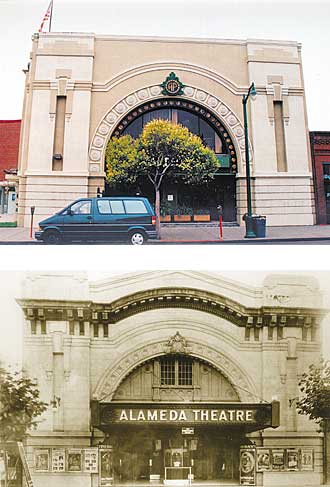
Stop 9:
Alameda Theatre
2420 Santa Clara Avenue
Completed in 1912; 1977
Erected in 1912 as a theater, this building at the southwest corner of Santa Clara and Park Avenues once housed a large auditorium with a lobby, balcony and lounges at the front, while a stage and dressing rooms were found at the rear.
The original, brick-constructed building was designed on a rectangular plan with a gabled roof. The stucco-clad facade, derived from Sullivanesque and Secessionist sources, features a large archway with a frieze of plaster medallions. A bracketed cornice and a large marquee suspended over the entry have been removed.
This now-commercial building was enlarged and converted to a bank in 1977. Additions included a second story, stuccoed elevator shaft, steel frame and brick-veneer entry wing, rear entry and landscaped areas. Seismic reinforcing, closure of the former entry arch and a partial restoration of the facade were also performed.
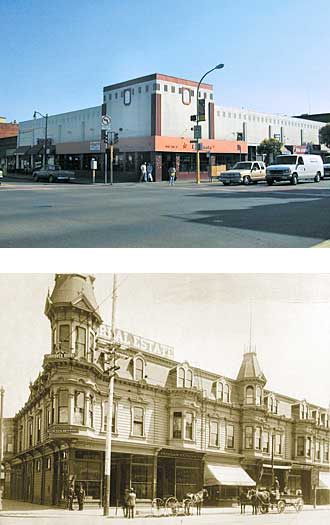
Stop 10:
Tucker Building
1430-1440 Park Street and
2402-2406 Santa Clara Avenue
Completed in 1879
Altered in 1933
Beneath the stucco and wood facade of this building is the remnant of an ornate, three-story Italianate landmark. The original structure was built for Dr. Joseph C. Tucker on a portion of the grounds previously occupied by his Alameda Park Asylum, a privately-run insane asylum. The grounds of the asylum fronted Park Street on the east side between Central and Webb. The facility closed in 1870, and burned to the ground a month later.
The Tucker Building, designed by Alameda architect Joseph Sherwin, was built in two phases for a total cost of $13,000. The ground floor housed a variety of commercial tenants, including Alameda’s main post office between 1879-1890. The second floor held professional offices, while the third floor - left unfinished until 1882 - contained furnished rooms for rent.
Purchased shortly after World War I by local real estate agent Edward Shaw, the building was completely remodeled in 1933, at a cost of $7,000. The design by San Francisco architect H. A. Minton is a fine example of the Moderne style, now currently the home of one of Alameda's most successful restaurants, La Penca Azul.
The building is a contributor to the Park Street Historic Commercial District (National Register, 1982).
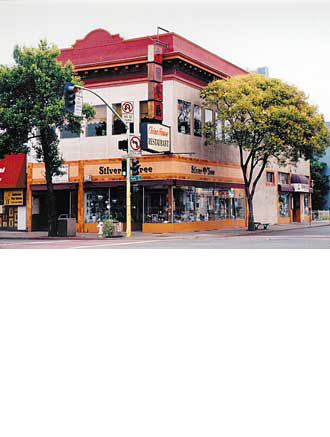
Stop 11:
Schroeder Building
1435-1437 Park Street
Completed in 1873; 1889; 1909
Believe it or not, this is the oldest building in what is officially designated as the Historic District. It was built in 1873 for Fritz Boehmer, a local merchant and real estate developer. Fritz moved his grocery and hardware business into the ground floor, and the upper floor contained a public meeting hall. The Masons leased that space until their new (1891) hall was built at the corner of Park Street and Alameda Avenue.
In 1876, Fritz sold the building to Adolph Schroeder (co-owner of a local feed and fuel business), who used it as rental property. He expanded the building in 1889. Between 1882 – 1894, a portion of the ground floor housed Alameda’s first telephone exchange.
While significantly altered over the years, it retains enough of its original design to be a contributor to the district.

Stop 12:
Citizens Bank of Alameda / Bank ofAmerica Building
1500-1504 Park Street
Completed in 1907; 1924
The second reinforced concrete structure on Park Street, the Citizens Bank building was completed in 1907 at a cost of $30,000. It was designed by Oliver & Foulkes, and built by Grank B. Gulbreth & Co. Its neoclassical styling features Ionic columns along the Park Street facade.
Citizens Bank was acquired in the 1920's by the Bank of Italy, which was to become the Bank of America in 1930. An addition, completed in 1924, nearly quadrupled its size to the current dimensions.
The building is a contributor to the Park Street Historic Commercial District (National Register, 1982).
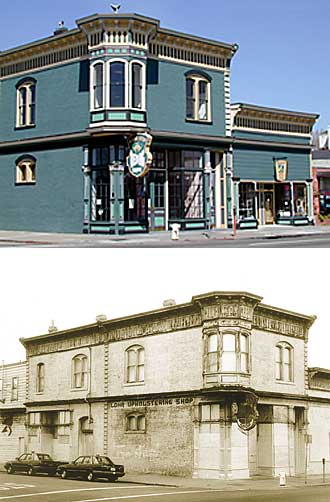
Stop 13:
Fossing Building
1629 Park Street
Completed in 1886
Referred to simply as the "Silver Building" for years by many Alamedans, the Fossing building was erected in 1886 by its original owner, John Charles Fossing, for his grocery business. The Fossing family resided in the building’s upper floor.
The architect and builder was Charles Foster, who also built Alameda's first high school and first town hall, and served as general contractor for the Carnegie Library. The only surviving commercial structure in Alameda designed and built by Foster, this Italianate structure is noteworthy for the quality of construction and use of fireproof materials, such as brick, cast iron, and sheet metal.
Sold by the Fossings in 1937 to the Lohr family, the building housed the Lohr Upholstery Shop until 1970. It remained vacant for roughly a quarter century, coated in silver paint.
Now under new ownership, the building has undergone an extensive restoration and has been returned to a bona fide commercial use by the arrival of new tenants.
National Register of Historic Places
Park Street Historic Commercial District:
1982 Nomination Form (PDF)
Special thanks to the City of Alameda's Planning Department for whom much of this work was originally conducted; the California Office of Historic Preservation, who provided financial assistance for that work; and Woody Minor, from whose book "Historical Commercial Buildings of Alameda", we liberally ripped-off cool facts.
An even bigger thanks to those property owners who realize that their buildings belong, in part, to the community of Alameda, and work to preserve and protect their architectural significance.

 In the beginning...
In the beginning...